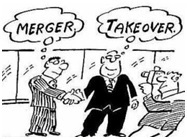|
 |
|
 |
|
|
||
Mergers and acquisitions (M &
A’s)
Mergers are... Two companies joining as equal partners.
Acquisitions are... One company buying another and taking control of it e.g. the purchase of the British chocolate maker, Cadbury, by the American food company, Kraft.
How to make M & A’s work
1. Compatible cultures M & A’s won’t be successful, if the employees in each company have different values and attitudes (e.g. one company is less creative).
2. Leadership and customer satisfaction The boss of the bigger company must make sure everyone is focused on customer satisfaction, not just the implementation of the merger or acquisition.
3. Complementary skills and core competencies Only buy or merge with a company that has the skills and products you need to:
Synergy will be hoped for, where the new business performs better than the two companies operating separately. 4. Motivate people
5. Benefit from economies of scale M & A’s make an organization bigger, so enabling it to benefit more from economies of scale (the cost savings of large scale production)- for example:
6. Avoid diseconomies of scale These result in higher costs because the bigger company is more difficult to manage because of problems in points 1 to 4 above. The biggest difficulty is likely to be a culture clash when the two companies believe in different things (see point 1 above).
7. Leveraged buy-outs (LBO’s) Employees borrow money to buy their company to avoid an unwanted takeover bid. When managers do this, it’s called a management buy-out (MbO).
Key quotes explained
“Big is beautiful” A slogan commonly used in the 1960’s to describe the benefits of economies of scale from bigger
companies. It contrasts with the phrase, “Small is beautiful”, coined by Fritz Schumacher.(pictured right)
“Success is 5% strategy, 95% execution” - Percy Barnevik , ex-boss of the Swedish engineering company, ABB (pictured right) Choosing the right company to buy or merge with is much easier than making the merger or acquisition work.
“Strategy must in the long run be responsive to human needs” - Kenneth Andrews, American business professor (pictured right) M & A’s don’t work, if employees’ needs aren’t satisfied.
“It’s far better to buy a wonderful company at a fair price than a fair company at a wonderful price” - Warren Buffett , American share investor (pictured right) Wise advice on buying a company.
Best books and articles
Bryan Burrough (pictured right) , Barbarians at the Gate (1990) Best-seller about the unethical financial dealings surrounding the leveraged buy-out of Nabisco, the makers of Shredded Wheat. Three rules apply:
Michael Porter (pictured right) , From Competitive Advantage to Corporate Strategy (1987 Harvard Business Review article) Diversification is only successful if:
Satisfying these three tests is so difficult that most diversification fails. Diversification is most successful if businesses are successfully interrelated to achieve a common organizational purpose. |
|
|
||
|
|
||
| Copyright © wisdomtowin.com 2025 All Rights Reserved | ||
|












